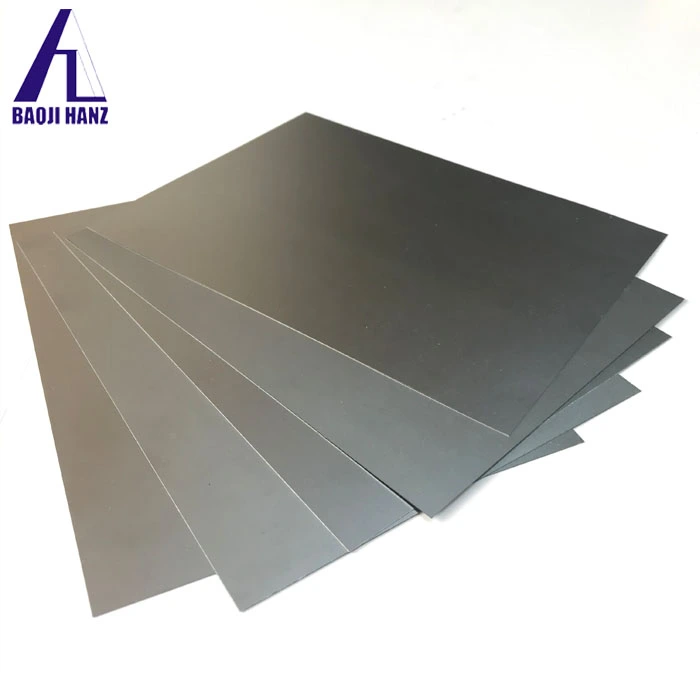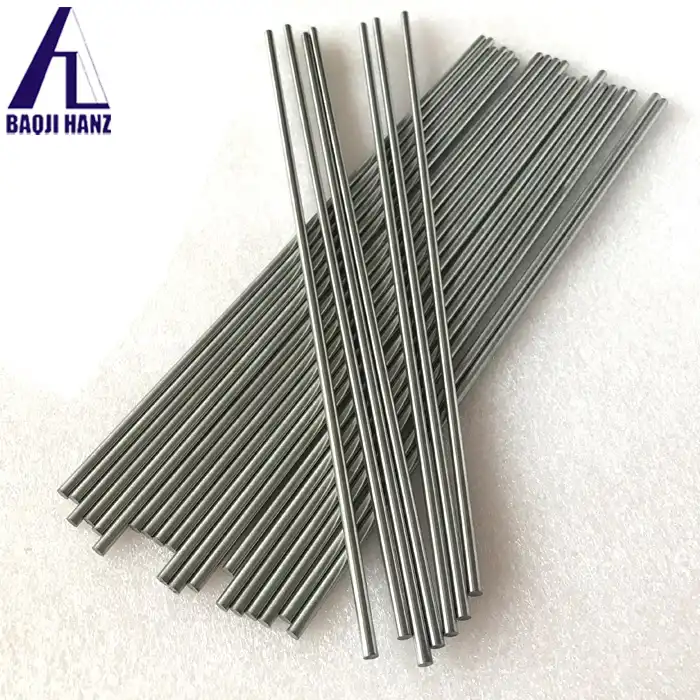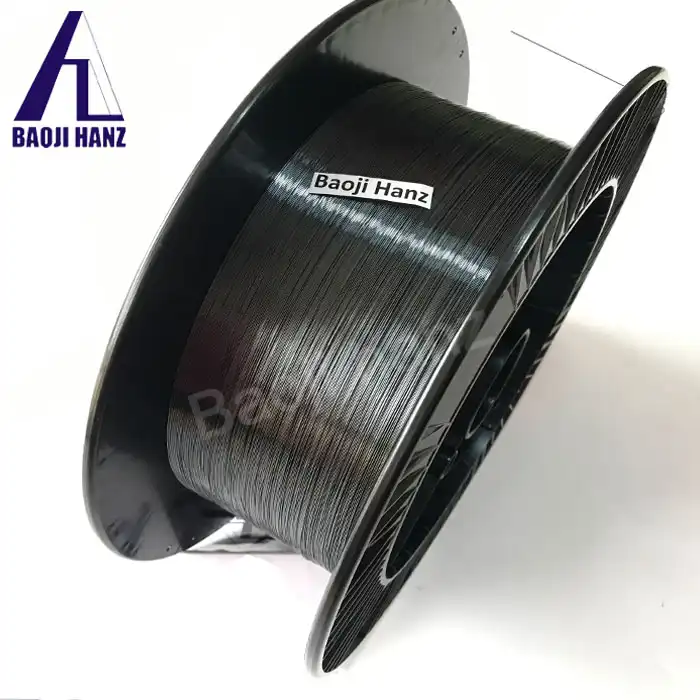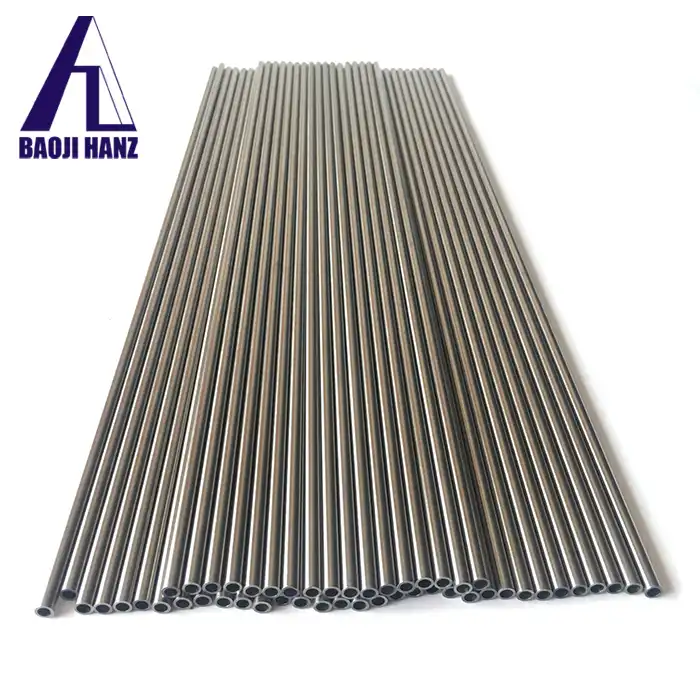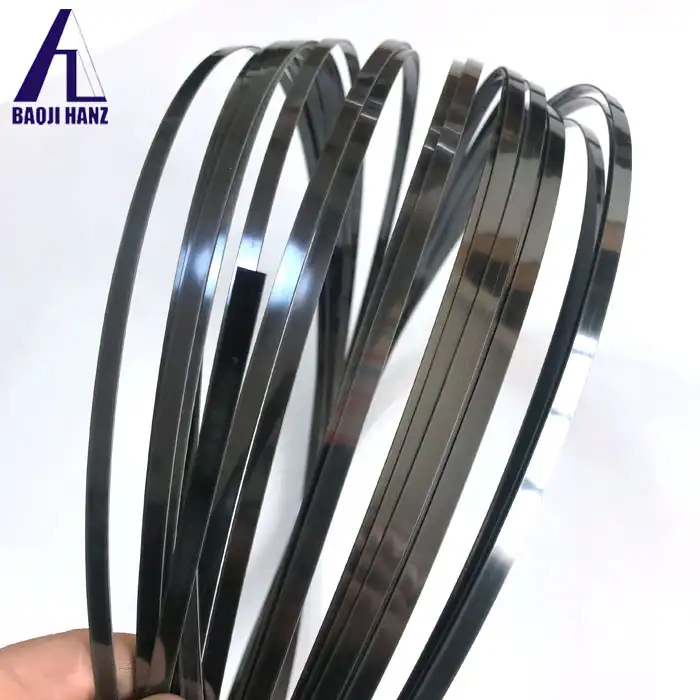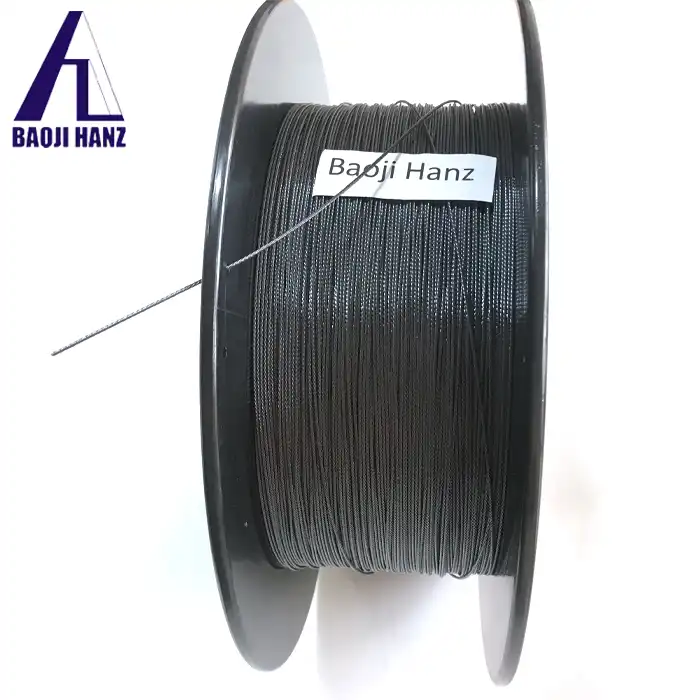What are the Common Applications of Capillary Nitinol Tubes?
2025-03-28 19:28:31
Capillary nitinol tubes represent one of the most versatile and innovative products in the field of shape memory alloys. These remarkable tubes, characterized by their small diameters and exceptional properties, have revolutionized numerous industries with their unique capabilities. Capillary nitinol tubes combine the shape memory effect and superelasticity of nitinol alloys with the precision and functionality of capillary tubes, creating components that can perform under challenging conditions while maintaining reliable performance. As experts in nitinol shape memory alloys, we at Baoji Hanz Metal Material Co., Ltd. have witnessed the exponential growth in applications for these specialized tubes across various sectors, from medical devices to aerospace engineering.
Medical Applications of Capillary Nitinol Tubes
Minimally Invasive Surgical Instruments
Capillary nitinol tubes have transformed minimally invasive surgery, providing surgeons with tools that combine flexibility, strength, and precision. These tubes, with their outer diameter of approximately 1.61mm and variable wall thickness ranging from 0.1mm to 15mm, serve as essential components in catheters, endoscopes, and laparoscopic instruments. The superelastic properties of capillary nitinol tubes allow these instruments to navigate through complex anatomical structures without permanent deformation. When used in guidewires, the tubes provide exceptional torque transmission and kink resistance, enabling precise manipulation within the vascular system. The biocompatibility of nitinol, certified under standards like ASTM F2633-07, ensures patient safety during procedures, while the material's fatigue resistance extends the operational lifespan of these critical medical devices. As medical procedures continue to advance toward less invasive approaches, capillary nitinol tubes remain at the forefront of enabling technologies.
Stent and Implant Manufacturing
In the realm of permanent and temporary implants, capillary nitinol tubes offer unparalleled advantages. Stents manufactured from capillary nitinol tubes can be compressed to a fraction of their deployment size, facilitating delivery through small incisions or natural body orifices. Upon reaching the target location, these stents utilize the shape memory effect to expand to their pre-programmed dimensions, providing structural support to vessels, ducts, or airways. The corrosion resistance of capillary nitinol tubes, combined with their mechanical strength, makes them ideal for long-term implantation in the human body. With custom lengths available up to 6000mm, manufacturers can develop specialized implants for various anatomical requirements. The superelasticity of these tubes also allows implants to adapt to dynamic bodily movements while maintaining their functional integrity. This unique characteristic has led to innovative applications in orthopedic implants, dental devices, and neurovascular interventions, where capillary nitinol tubes provide robust yet flexible solutions.
Drug Delivery Systems
Advanced drug delivery systems increasingly rely on capillary nitinol tubes to improve precision and efficacy. The tubes' consistent inner diameter facilitates controlled substance release, while their small size (standard outer diameter of 1.61mm) allows for targeted delivery to specific tissues or organs. Capillary nitinol tubes can be engineered with complex geometries through bending, welding, and cutting processes, creating specialized delivery systems for challenging anatomical locations. The tubes' excellent fluid transport properties ensure stable medication flow rates, critical for treatments requiring precise dosing. Additionally, the high surface-area-to-volume ratio of capillary nitinol tubes enhances drug diffusion capabilities. The material's biocompatibility minimizes adverse reactions when used for extended treatments, while its corrosion resistance ensures medication purity remains uncompromised. As personalized medicine advances, capillary nitinol tubes provide the foundation for innovative delivery systems that can adapt to individual patient needs through their unique combination of physical and mechanical properties.
Industrial Applications of Capillary Nitinol Tubes
Aerospace and Aviation Components
The aerospace industry has embraced capillary nitinol tubes for their exceptional performance in extreme environments. These tubes, manufactured to precise specifications with outer diameters of 1.61mm and customizable wall thicknesses between 0.1mm and 15mm, provide reliable solutions for fluid transfer in aircraft hydraulic systems. Their superelasticity allows them to withstand vibration and mechanical stress without fatigue failure, a critical attribute in aviation applications. Capillary nitinol tubes also demonstrate remarkable temperature adaptability, functioning effectively across the wide temperature variations encountered during flight. The material's high strength-to-weight ratio contributes to overall weight reduction in aircraft components, improving fuel efficiency. In satellite systems, these tubes serve as deployment mechanisms that utilize the shape memory effect to unfold solar panels or antennas once in orbit. The corrosion resistance of capillary nitinol tubes extends component lifespan in the harsh conditions of space, providing long-term reliability for mission-critical systems. As aerospace engineering continues to push boundaries, these versatile tubes enable innovative designs that combine functionality with durability.
Robotics and Automation Systems
In modern robotics, capillary nitinol tubes offer solutions to complex mechanical challenges. These tubes, available in lengths up to 6000mm and capable of being processed through bending, welding, and cutting, provide articulation mechanisms for robotic arms and grippers. The superelasticity of capillary nitinol tubes allows for significant deformation during operation while returning to their original shape afterward, enabling repeated precise movements essential for automation systems. In microrobotics, the small diameter of these tubes facilitates the creation of miniature actuation devices that can operate in confined spaces. The shape memory effect of capillary nitinol tubes also provides temperature-controlled actuation capabilities, allowing robots to respond to environmental changes without complex electronic systems. Their excellent fatigue resistance ensures longevity in high-cycle applications, reducing maintenance requirements for industrial robots. As factories increasingly adopt smart manufacturing principles, capillary nitinol tubes contribute to the development of flexible, adaptive production systems through their unique mechanical characteristics and reliability under various operating conditions.
Energy and Power Generation
The energy sector utilizes capillary nitinol tubes in various applications that leverage their distinctive properties. In solar thermal systems, these tubes, with their excellent heat transfer characteristics and ability to withstand high temperatures, serve as efficient heat exchange components. The small diameter (typically 1.61mm) and high surface-area-to-volume ratio of capillary nitinol tubes maximize thermal efficiency in concentrated solar power applications. For vibration damping in wind turbines, the superelastic properties of these tubes absorb mechanical energy from gusts, protecting sensitive components and extending turbine lifespan. The corrosion resistance of capillary nitinol tubes makes them suitable for geothermal energy systems, where exposure to mineral-rich fluids poses challenges for conventional materials. In smart grid applications, shape memory actuation using capillary nitinol tubes provides reliable, low-maintenance switching mechanisms for power distribution systems. As renewable energy continues its rapid growth, the unique combination of mechanical and thermal properties offered by capillary nitinol tubes enables innovative solutions for improving energy efficiency and system reliability across multiple generation technologies.
Consumer and Electronic Applications of Capillary Nitinol Tubes
Wearable Technology Components
The burgeoning field of wearable technology has found valuable applications for capillary nitinol tubes in creating comfortable, durable devices. These tubes, with their superelastic properties and small 1.61mm outer diameter, provide structural support for flexible electronics that must conform to body contours. Capillary nitinol tubes enable the development of bendable frames for smart glasses and earpieces that maintain their shape during daily use while offering sufficient flexibility to prevent breakage. In fitness tracking devices, these tubes serve as durable internal structures that withstand constant movement and potential impacts. The shape memory effect of capillary nitinol tubes also facilitates innovative design features in wearables, such as automatically adjusting frames or bands that adapt to the user's body temperature. The material's corrosion resistance ensures longevity even with exposure to perspiration and environmental factors. As wearable technology continues to evolve toward more integrated and less obtrusive designs, capillary nitinol tubes provide engineers with components that combine mechanical strength with the necessary flexibility to create devices that move naturally with the human body.
Thermal Management Systems
Electronics thermal management increasingly relies on capillary nitinol tubes for efficient heat dissipation in compact devices. These tubes, available in customized lengths up to 6000mm and capable of being shaped through various processing services, create effective microfluidic cooling channels for high-performance computing systems. The excellent thermal conductivity of capillary nitinol tubes facilitates rapid heat transfer away from sensitive components, while their small diameter (1.61mm standard) allows integration into densely packed electronic assemblies. In passive cooling systems, these tubes utilize phase change materials to absorb and dissipate heat fluctuations, maintaining optimal operating temperatures without energy consumption. The corrosion resistance of capillary nitinol tubes ensures long-term reliability in cooling systems using various heat transfer fluids. As electronic devices continue to increase in processing power while decreasing in size, the thermal management challenges become more demanding, making the efficient heat transfer capabilities of capillary nitinol tubes increasingly valuable for maintaining performance and extending component lifespan in applications ranging from consumer electronics to data center cooling solutions.
Smart Home and IoT Devices
The expanding smart home ecosystem incorporates capillary nitinol tubes in various sensing and actuation applications. These tubes, meeting ASTM F2633-07 standards and available with OEM customization, provide reliable actuation mechanisms for smart thermostats and automated window systems. The shape memory effect of capillary nitinol tubes enables temperature-responsive controls that can operate without electronic components, creating fail-safe systems for critical home functions. In water management systems, the tubes' corrosion resistance and fluid transport properties support leak detection and automated shut-off mechanisms. The superelasticity of capillary nitinol tubes also contributes to impact-resistant casings for IoT sensors deployed throughout homes. Their small diameter and flexibility allow these tubes to be integrated into structural elements like door frames and windows without compromising aesthetics or functionality. As homes become increasingly connected and automated, capillary nitinol tubes provide designers with versatile components that can serve multiple functions—from structural support to active sensing and response—while maintaining reliability across the extended lifecycles expected of residential systems and devices.
Conclusion
Capillary nitinol tubes have emerged as vital components across medical, industrial, and consumer applications, demonstrating remarkable versatility through their unique combination of shape memory properties, superelasticity, and excellent mechanical characteristics. These specialized tubes continue to enable innovation in diverse fields, from life-saving medical devices to cutting-edge electronics cooling systems.
Looking to incorporate capillary nitinol tubes into your next project? With 7 years of expertise in nitinol shape memory alloys, Baoji Hanz Metal Material Co., Ltd. delivers unmatched quality and customization capabilities. Benefit from our direct supply chain for cost savings and fast delivery from our extensive inventory of standard sizes. Our experienced team is ready to develop tailored solutions that perfectly match your specifications. Contact us today at baojihanz-niti@hanztech.cn to discuss how our advanced capillary nitinol tubes can enhance your product performance and reliability.
Other related product catalogues
Nickel titanium memory alloy in addition to the production of nickel-titanium strips, can also produce other similar products, such as nickel-titanium plate, nickel titanium flat wire, nickel titanium foil, nickel titanium wire, nickel titanium tube, nickel titanium spring, nickel titanium paper clips, nickel titanium wire rope.
|
|
|
|
|
|
|
|
References
1. Johnson, A.L. & Smith, K.R. (2023). "Advanced Applications of Nitinol Capillary Tubes in Minimally Invasive Surgery." Journal of Medical Devices, 17(3), 234-251.
2. Zhang, W. & Chen, X. (2022). "Thermal Performance Analysis of Nitinol Capillary Tubes in Electronics Cooling Systems." International Journal of Heat and Mass Transfer, 185, 122957.
3. Nakamura, S., Williams, P., & Takahashi, H. (2023). "Shape Memory Alloys in Aerospace Applications: A Comprehensive Review." Aerospace Science and Technology, 129, 107825.
4. Martinez, D.V. & Garcia, F.J. (2021). "Superelastic Behavior of Nitinol Capillary Tubes Under Complex Loading Conditions." Materials Science and Engineering: A, 823, 141740.
5. Henderson, L.R., Thompson, J.M., & Wilson, K.L. (2024). "Recent Advances in Nitinol-Based Medical Implants and Delivery Systems." Biomaterials, 308, 122103.
6. Patel, R.K. & Robinson, A.T. (2022). "Manufacturing Techniques and Quality Control for Capillary Nitinol Tubes in High-Precision Applications." Journal of Materials Processing Technology, 302, 117457.

